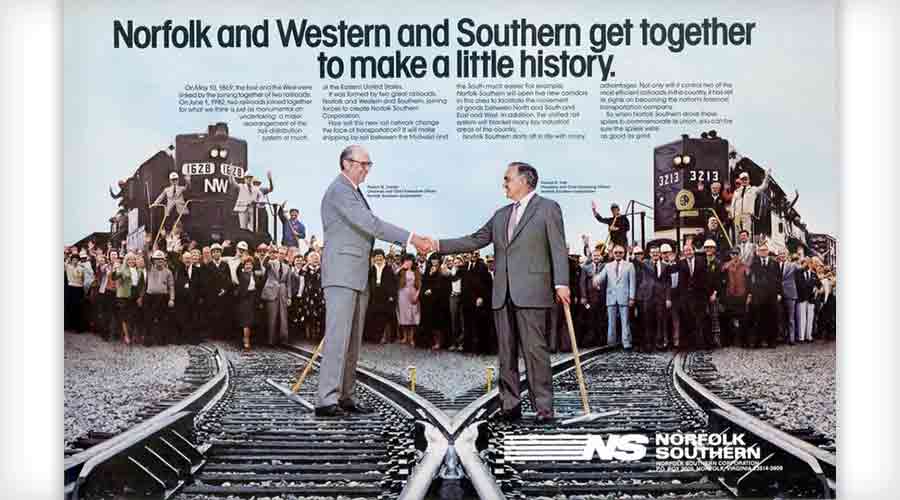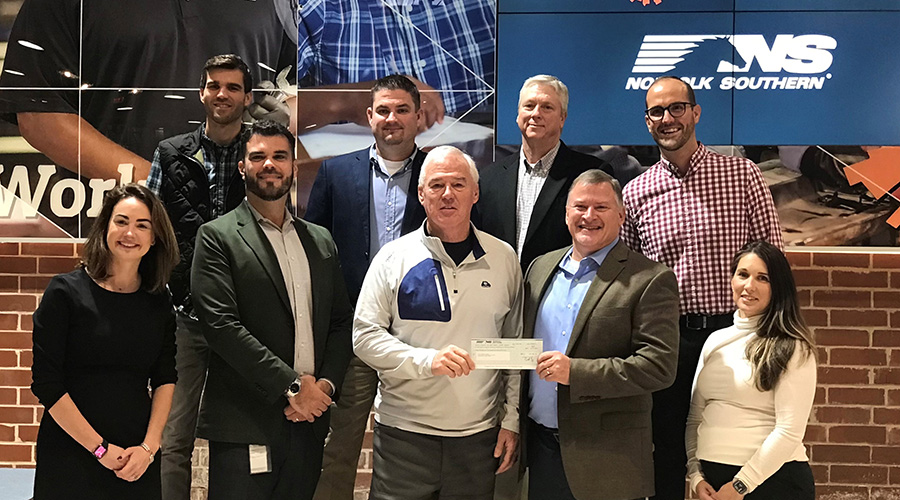NS looks back at past 40 years, looks ahead to a more operations-oriented future
6/14/2022
By Jeff Stagl, Managing Editor
June 1 was a big day for Norfolk Southerners. The Class I marked its 40th anniversary. Including predecessor railroads, NS’ history dates back nearly two centuries to 1827.
On June 1, 1982, the Southern Railway and Norfolk & Western Railway merged to form Norfolk Southern Corp. Assigned an "NSC" ticker symbol, NS’ stock on its first day of trading recorded a price of $42.87 per share and volume of 120,200 shares.
At the time, the two merging railroads predicted the combined entity — which was more commonly known as Norfolk Southern Railway — would become the nation’s foremost transportation company. NS aimed to blanket many key U.S. industrial areas and open five new corridors to facilitate the movement of cargo between points in the North and South, and in the East and West. The idea: to make shipping goods easier between the East, South and Midwest.
 On June 1, 1982, the Norfolk & Western Railway and Southern Railway officially merged. Presidents of the N&W and Southern Railway at the time (pictured left to right), Robert Claytor became NS’ first CEO and Harold Hall became its first president and COO. Norfolk Southern Corp.
On June 1, 1982, the Norfolk & Western Railway and Southern Railway officially merged. Presidents of the N&W and Southern Railway at the time (pictured left to right), Robert Claytor became NS’ first CEO and Harold Hall became its first president and COO. Norfolk Southern Corp.NS initially was led by the late Robert Claytor, who served as CEO from 1982 to 1987. The succeeding five CEOs and their length of duty were the late Arnold McKinnon (1987-1992), David Goode (1992-2005), Wick Moorman (2005-2013) and James Squires (2013-2022). Alan Shaw currently serves as president and CEO.
NS now operates more than 19,000 miles of track in 22 states and the District of Columbia; employs more than 18,000 people; serves every major eastern U.S. port; is a major transporter of industrial products and a principal carrier of coal, autos and automotive parts; and operates an extensive intermodal network in the East.
Seminal moments over the past four decades include:
• becoming the first Class I to move 1 million containers and trailers in a given year in 1987;
• opening the company’s new 21-story headquarters in Norfolk, Virginia, in 1988;
• winning a first gold E. H. Harriman Memorial Award for safety in 1990, and then proceeding to win the annual honor 23 straight times;
• registering more than $1 billion in annual rail operations income for the first time in 1994;
• acquiring and integrating a major portion of Conrail in 1999, boosting NS’ size by 50% and returning competitive rail service to the Northeast for the first time since the 1970s;
• unveiling the major double-stack Heartland Corridor intermodal route in 2010;
• consolidating from three to two operating regions in 2016 as part of a five-year strategic plan;
• developing and deploying an autonomous track geometry measurement system in 2020; and
• opening the organization’s new 750,000-square-foot headquarters in Atlanta in 2021.
To commemorate the 40th anniversary, Shaw and other NSers rang the opening bell at the New York Stock Exchange on June 7. The contingent included members of various departments, front-line workers and non-agreement employees. NS officials previously rang the exchange’s bell in 1982, 2005, 2007 and 2012.
 NS received a certificate from the NYSE on June 2, 1982, for satisfying its stock listing requirements. Norfolk Southern Corp.
NS received a certificate from the NYSE on June 2, 1982, for satisfying its stock listing requirements. Norfolk Southern Corp.“Great morning ringing the opening bell … to celebrate 40 years since the historic merger that created Norfolk Southern Corp. and mark nearly 200 years of serving customers and powering our nation's economy,” Shaw posted on Twitter June 7. “Our CFO Mark George and I were proud to be joined by a group of railroaders working on the front lines to keep our trains moving and represent our #ThoroughbredPride.”
Association of American Railroads President and CEO Ian Jefferies acknowledged NS for reaching the milestone.
“Norfolk Southern has been a critical economic connector over the past 40 years, delivering for customers and communities alike throughout its network,” he said in an email.
Likewise, American Short Line and Regional Railroad Association (ASLRRA) President Chuck Baker congratulated the Class I.
“NS has long been an active partner in supporting the integration of short-line movements into their connecting services, allowing small business railroads and the thousands of businesses we serve in small town and rural America to thrive,” he said in an email. “NS connects with well north of 200 short lines, and each of those connections is a win-win-win for rail customers, short lines and NS.”
But NS won’t continue to grow and progress by living in the past. As Jefferies put it: “At the same time NS recognizes its proud legacy, we know the company is focused on meeting tomorrow’s challenges and will continue powering our economy alongside the rest of the freight rail industry into the future.”
Although the Class I has a rich history, it also has a vital purpose and a bright future, Shaw said.
“We continue to play an essential role in serving our customers and powering our nation’s economy,” he said. “We’re focusing on becoming more customer-centric and operations-driven by implementing a plan built around service, productivity and growth.”
 Several years ago, NS created a series of locomotives to commemorate all its predecessors, including one that honors the Southern Railway. Norfolk Southern Corp.
Several years ago, NS created a series of locomotives to commemorate all its predecessors, including one that honors the Southern Railway. Norfolk Southern Corp.The plan Shaw’s referring to is TOP|SPG, the first three letters of which stand for Thoroughbred operating plan, and the latter three for service, productivity and growth. The next generation of the NS’ precision scheduled railroading operating plan, TOP|SPG will enable the Class I to take a data-driven, customer-centric approach to foster more collaborative and comprehensive performance.
The new plan will incorporate the intermodal, auto and unit train networks, and be fully aligned around a return to the service levels that customers expect, NS leaders say.
TOP|SPG is being developed via a ground-up, clean-slate approach to remove historical constraints and take a fresh look at operating needs. The plan will be implemented in phases, with a rollout to begin in the second quarter and continue through 2022.
NS also continues to be a driver of RailPulse, a joint venture that’s worked to facilitate and accelerate the adoption of GPS and other telematics technology across the North American rail-car fleet. The goal is to provide real-time information and sustained visibility of a rail car’s status, location and condition to shippers, rail-car owners and railroads.
Union Pacific Railroad recently joined RailPulse, which also counts NS, Watco, Genesee & Wyoming Inc., TrinityRail, GATX Corp. and The Greenbrier Cos. as members. The joint venture recently entered into a 10-year agreement with Railinc to develop, maintain and operate RailPulse’s technology platform for monitoring rail-car location, condition and health characteristics across North American supply chains.
“As the rail industry modernizes, we particularly congratulate NS on their leadership in RailPulse, which will hopefully play a foundational role as the rail industry collaborates to provide improved service to our valued customers,” said the ASLRRA’s Baker.



